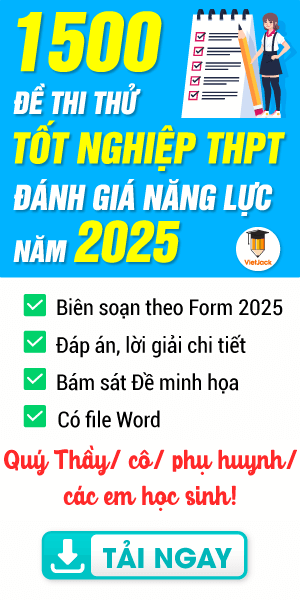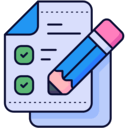Giáo án Tiếng Anh 12 Global Success Unit 3 Reading
Giáo án Tiếng Anh 12 Global Success Unit 3 Reading
Chỉ từ 300k mua trọn bộ Kế hoạch bài dạy (KHBD) hay Giáo án Tiếng Anh 12 Global Success bản word phong cách hiện đại, trình bày đẹp mắt, dễ dàng chỉnh sửa:
- B1: gửi phí vào tk:
1133836868- CT TNHH DAU TU VA DV GD VIETJACK - Ngân hàng MB (QR) - B2: Nhắn tin tới Zalo VietJack Official - nhấn vào đây để thông báo và nhận đề thi
I. OBJECTIVES
By the end of this lesson, Ss will be able to:
1. Knowledge
- Read for specific information in emails about green ways to deal with plastic
2. Competences
- Develop communication skills and creativity
- Be collaborative and supportive in pair work and teamwork
- Actively join in class activities
3. Personal qualities
- Be responsible for saving the environment
- Develop self-study skills
II. MATERIALS
- Grade 12 textbook, Unit 3, Reading
- Computer connected to the Internet
- Projector / TV
III. PROCEDURES
1. WARM-UP (5 mins)
|
a. Objectives: - To stir up the atmosphere and activate students’ knowledge about the figure they are going to learn about in the lesson; - To set the context for the reading part; - To enhance students’ skills of cooperating with teammates. b. Content: - Video watching c. Expected outcomes: - Students join the activity enthusiastically and gain knowledge on the topic. d. Organisation: |
|
|
TEACHER- STUDENTS’ ACTIVITIES |
CONTENTS |
|
Video watching - Teacher plays the video. - Students watch the video. - Teacher asks students some questions related to the video. - Students raise their hands to answer the questions. - Teacher observes and gives feedback to students’ answers. |
Link: https://www.youtube.com/watch?v=_6xlNyWPpB8 Questions: 1. How many stories are there in the video? 2. What happened to the first plastic bottle? 3. What happened to the second plastic bottle? 4. What happened to the third plastic bottle? |
e. Assessment
- Teacher observes and gives feedback.
2. ACTIVITY 1: PRE-READING (9 mins)
|
a. Objectives: - To get students learn vocabulary related to the topic; - To activate prior knowledge about the topic and get Ss involved in the lesson. b. Content: - Task 1: Work in pairs to solve the quiz. (p.35) - Pre-teach vocabulary c. Expected outcomes: - Students can identify some vocabulary related to the topic. d. Organization |
|
|
TEACHER- STUDENTS’ ACTIVITIES |
CONTENTS |
|
Task 1. Work in pairs to solve the quiz. (4 mins) - Have Ss look at the picture and elicit the topic, e.g. There is too much plastic waste. Our oceans and rivers are polluted by plastic. Millions of plastic bottles and bags end up in our oceans every year. - Students work in pairs and solve the quiz. - Read through the quiz and check understanding. - Ask Ss to work in pairs to answer the questions. - Ask some pairs to share their answers with the whole class. - Ask what other information they want to know about the topic. Write their questions on the board. - Students write questions they want to know on the board. |
Key: 1. C 2. C 3. A 4. A |
|
Vocabulary pre-teaching (5 mins) - Teacher introduces the vocabulary. - Teacher explains the meaning of the new vocabulary by pictures. Students listen to the teacher’s explanation and guess the words. - Teacher checks students’ understanding with the “Rub out and remember” technique. Students write down the new words in their notebook. - Teacher reveals that these five words will appear in the reading text and asks students to open their textbook to discover further. |
New words: 1. leftover (n) 2. contaminated (adj) 3. get rid of 4. rinse (v) 5. convenience (n) |
e. Assessment
- Teacher checks students’ pronunciation and gives feedback.
- Teacher observes Ss’ writing of vocabulary in their notebooks.
3. ACTIVITY 2: WHILE-READING (20 mins)
a. Objectives:
- To get Ss to practise guessing the meaning of words from context;
- To help Ss develop reading skills for general information;
- To help Ss develop reading skills for specific information.
b. Content:
- Task 2: Read some extracts from the emails sent to the Teen magazine. Match the highlighted words and phrases (1-4) with the pictures (a-d). (p.36)
- Task 3: Read the email extracts again. Complete the summary notes with information from the text. Use no more than TWO words for each gap. (p.37)
- Task 4: Read the email extracts again. Match the following information with the right names. (p.37)
c. Expected outcomes:
- Students can thoroughly understand the content of the text and complete the tasks successfully
d. Organisation
|
TEACHER- STUDENTS’ ACTIVITIES |
CONTENTS |
|
Task 2: Read some extracts from the emails sent to the Teen magazine. Match the highlighted words and phrases with the pictures. (6 mins) - Ask Ss to read the text. Ask them to locate the highlighted words/phrases in the text, e.g. 1. The phrase ‘cardboard boxes’ is found in the sentence: “The supermarket near my house even provides cardboard boxes.” - Students read the text and locate the highlighted words individually. - Ask students to study the context (including the sentence containing the word/phrase as well as neighbouring sentences) carefully, e.g. 1. I try to use fewer plastic bags when shopping. The supermarket near my house even provides cardboard boxes so I can pack my groceries and get rid of plastic packaging! - Students study the context and do the tasks as required. - Encourage Ss to study the pictures to see which one best represents the word/phrase. E.g. 1. Picture C is the correct match, because it shows images of boxes which can be used to contain things such as groceries and can replace plastic bags at stores and supermarkets. - In weaker classes, check understanding of the words by asking Ss to make sentences with them. |
Answer key: 1. c 2. a 3. d 4. b Strategy: Reading for vocabulary To read and understand the meanings of words/phrases in context, students should: 1. Locate the word or phrase in the text. 2. Study the context (including the sentence containing the word/phrase as well as neighbouring sentences) carefully. 3. Try to replace the word/phrase with each choice to see which one best replaces the word/phrase. |
|
Task 3: Read the email extracts again. Complete the summary notes with information from the text. Use no more than TWO words for each gap. (7 mins) - Ask Ss to study the summary notes to get the general ideas. Make sure they understand that each idea on the right are examples of ways to deal with single-use plastic on the left. In weaker classes, give Ss an example, e.g. To reduce the use of single-use plastic, we could use cardboard boxes instead of plastic packaging. - Students read the extracts again. - Draw their attention to each gap. Encourage Ss to guess the type of information they need for each gap. E.g. For Blank (1) we need a noun or noun phrase in plural. For Blank (2) it isa singular noun or noun phrase. - Underline key words in the notes to locate the information in the passage. E.g. Blank (1) is related to the idea of reducing plastic packaging. Therefore, it can be found in the first extract (by Hai, 18). - Students write no more than two words for each gap. - Read the parts that contain the key words carefully to identify the words/phrases. - Make sure the word/phrase for each blank is exactly the same as taken from the passage. It should fit the gap in terms of both form and meaning. Finally, it should not exceed the word limit. - Students check answers with the whole class and give explanations for their choice. - Check answers as a class. |
Answer key: 1. cardboard boxes 2. reusable 3. plastic bags 4. numbers 5. rinse out |
|
Task 4: Read the email extracts again. Match the following information with the right names. (7 mins) - Ask Ss to study the list of people's names and locate them in the passage. Remind them that their names can be found at the end of the extracts. - Encourage Ss to underline key words in the statements. E.g. 1. This person has learnt from a past mistake how to recycle things properly. 2. This person’s green lifestyle is supported by a local business. - Have Ss re-read each person's or ideas and compare them with the list of options. Encourage them to pay attention to paraphrases and implications (if any). E.g. Hai’s extract does not mention any mistake as in Statement 1, or recycling symbols in Statement 3. Nor does it talk about the drinking water as in Statement 4 or the use of single-use containers as in Statement 5. However, it talks about a local business (i.e., “a the supermarket near my house”) and how it supports his/her green lifestyles (i.e., The supermarket near my house even provides cardboard boxes so I can pack my groceries and get rid of plastic packaging). So 2 is the correct match with Hai. - Students do the matching. - Students compare their answers with partners then check with the whole class. - Check answers as a class. |
Answer key: 1. e 2. a 3. d 4. b 5. c |
e. Assessment
- Teacher’s observation on Ss’ performance.
- Teacher’s feedback and peers’ feedback.
4. ACTIVITY 3: POST-READING (8 mins)
|
a. Objectives: - To check students’ understanding about the reading passage; - To help some students enhance presentation skills; - To practise team working; - To help Ss use the language and ideas from the unit to express their ideas and opinions. b. Content: - Task 5: Work in pairs. Discuss the following questions. (p. 37) c. Expected outcomes: - Students can use the language and ideas from the unit to talk about their habits. d. Organisation |
|
|
TEACHER- STUDENTS’ ACTIVITIES |
CONTENTS |
|
Task 5: Work in pairs. Discuss the following questions. (p. 37) - Ask Ss to work in pairs. Have them discuss which green habits mentioned in the article have been adopted by them. - Students practise speaking in pairs. Encourage them to say which ones they want to try in the future. - Students share their answers with the whole class. - Students listen and give feedback. - Invite some pairs to share their answers with the whole class. |
Suggested answers: Similarly to Hai, I try to use less plastics when I go shopping. I also reuse any takeaway containers like Hoang. Besides, I bring a reusable water bottle to school like Phuong. But I have never paid attention to the numbers at the bottom of plastic objects described by Ha. Neither do I rinse out plastic objects carefully before recycling them as Binh recommends. So I think I will try to adopt Ha’s and Binh’s green habits in the future. |
e. Assessment
- Teacher’s observation on Ss’ performance.
5. CONSOLIDATION (3 mins)
a. Wrap-up
- Teacher asks students to talk about what they have learnt in the lesson.
b. Homework
- Do exercises in the workbook.
- Write a paragraph about what green habits you would like to develop in the future.
- Prepare for the next lesson – Speaking.
................................
................................
................................
Trên đây là nguồn học liệu Giáo án Tiếng Anh 12 Global Success miễn phí của NXB Giáo dục Việt Nam. Để xem chi tiết, mời bạn tham khảo: Giáo án Tiếng Anh 12 Global Success (NXB Giáo dục)
Để mua Kế hoạch bài dạy (KHBD) hay Giáo án Tiếng Anh 12 năm 2025 mới nhất, mời Thầy/Cô vui lòng xem thử:
Xem thêm các bài soạn Giáo án Tiếng Anh lớp 12 Global Success (bộ sách Kết nối tri thức) chuẩn khác:
Đã có app VietJack trên điện thoại, giải bài tập SGK, SBT Soạn văn, Văn mẫu, Thi online, Bài giảng....miễn phí. Tải ngay ứng dụng trên Android và iOS.
Theo dõi chúng tôi miễn phí trên mạng xã hội facebook và youtube:Nếu thấy hay, hãy động viên và chia sẻ nhé! Các bình luận không phù hợp với nội quy bình luận trang web sẽ bị cấm bình luận vĩnh viễn.
- Giáo án lớp 12 (các môn học)
- Giáo án điện tử lớp 12 (các môn học)
- Giáo án Toán 12
- Giáo án Ngữ văn 12
- Giáo án Vật Lí 12
- Giáo án Hóa học 12
- Giáo án Sinh học 12
- Giáo án Địa Lí 12
- Giáo án Lịch Sử 12
- Giáo án Lịch Sử 12 mới
- Giáo án GDCD 12
- Giáo án Kinh tế Pháp luật 12
- Giáo án Tin học 12
- Giáo án Công nghệ 12
- Giáo án GDQP 12
- Đề thi lớp 12 (các môn học)
- Đề thi Ngữ văn 12
- Đề thi Toán 12
- Đề thi Tiếng Anh 12 mới
- Đề thi Tiếng Anh 12
- Đề thi Vật Lí 12
- Đề thi Hóa học 12
- Đề thi Sinh học 12
- Đề thi Địa Lí 12
- Đề thi Lịch Sử 12
- Đề thi Giáo dục Kinh tế Pháp luật 12
- Đề thi Giáo dục quốc phòng 12
- Đề thi Tin học 12
- Đề thi Công nghệ 12




 Giải bài tập SGK & SBT
Giải bài tập SGK & SBT
 Tài liệu giáo viên
Tài liệu giáo viên
 Sách
Sách
 Khóa học
Khóa học
 Thi online
Thi online
 Hỏi đáp
Hỏi đáp

